Hydrological Evaluation of CRA40 and ERA5 Reanalysis Precipitation Products over Ganjiang River Basin in Humid Southeastern China
Abstract
:1. Introduction
2. Region, Data and Methodology
2.1. Study Region
2.2. Data
2.3. Methodology
2.3.1. Hydrological Model
2.3.2. Parameter Calibration and Validation Method
2.3.3. Statistics Metrics
3. Results and Analysis
3.1. Assessment of Reanalysis Precipitation Products
3.2. Seasonal Statistics
3.3. Daily Series Mean Rainfall
3.4. Hydrologic Model Calibration
3.5. Hydrological Assessment of Reanalysis Precipitation Products
4. Summary and Conclusions
- (1)
- Both CRA40 and ERA5 products successfully capture the precipitation patterns in the Ganjiang River Basin from 1998 to 2008. At the daily scale, ERA5 shows closer agreement with ground-based rainfall gauge observations with a higher overestimation (13.11%), demonstrating better performance in terms of CC (0.67) and RMSE (7.92 mm/day). At the monthly scale, CRA40 exhibits a higher CC (0.92), slight underestimation (1.32%), and smaller RMSE (38.52 mm/day), aligning more closely with the observed rainfall from ground-based gauges. Throughout the study period, ERA5 consistently overestimates precipitation compared to CRA40. Both reanalysis products underestimate light precipitation events (<1 mm/day) and underestimate the amount of extreme precipitation (>30 mm/day) (Figure 2, Figure 3, Figure 4 and Figure 5).
- (2)
- In seasonal daily precipitation simulations, ERA5 consistently shows high CC values across seasons but tends to overestimate precipitation. Winter exhibits the best performance, while summer shows the highest overestimation (19.58%), with CC decreasing from 0.72 in winter to 0.63 in summer. In contrast, CRA40, except for a slight overestimation in summer, slightly underestimates precipitation in the other three seasons. The CC values are relatively lower across all four seasons for CRA40, particularly with a CC of only 0.37 in spring (Table 3).
- (3)
- The simulation of stream flows using CRA40 and ERA5 as forcings for the VIC model reveals that CRA40 achieves promising results with NSE values exceeding 0.6 at both daily and monthly scales, indicating good simulation performance. In contrast, ERA5 demonstrates poorer hydrological performance with NSE values below 0.3 at both daily and monthly scales. CRA40 and ERA5 overestimate stream flows by 36.6% and 51.43%, respectively, at the daily scale, and by 36.75% and 51.47%, respectively, at the monthly scale. Both products consistently overestimate stream flows during the monsoon season (April to September), particularly evident in the year 2004 (Figure 10 and Figure 12).
- (4)
- The precipitation dominance order of the reanalysis precipitation products is not reflected in their simulated stream flow results. CRA40 outperforms both ground-based rain gauge observations and ERA5 in simulating stream flows in the Ganjiang River Basin. At the daily (monthly) scale, the validation period NSE for CRA40 and ground-based rain gauge observations is 0.6 and 0.51 (0.65 and 0.55), respectively, while CC values are 0.91 and 0.89 (0.96 and 0.95), respectively. Across monthly variations, except for a slightly better stream flow performance in December and January to March, ERA5 exhibits an inferior CC, RB, and RMSE performance compared to CRA40 in other seasons (Figure 10, Figure 12 and Figure 13).
Author Contributions
Funding
Data Availability Statement
Acknowledgments
Conflicts of Interest
References
- Habib, E.; Henschke, A.; Adler, R.F. Evaluation of TMPA Satellite-Based Research and Real-Time Rainfall Estimates during Six Tropical-Related Heavy Rainfall Events over Louisiana, USA. Atmos. Res. 2009, 94, 373–388. [Google Scholar] [CrossRef]
- Tang, Q. Global Change Hydrology: Terrestrial Water Cycle and Global Chang. Sci. China Earth Sci. 2020, 50, 459–462. [Google Scholar] [CrossRef]
- Song, Y.; Wang, S.; Luo, P.; Zha, X.; Xu, C.; Cao, Z.; Zhu, W. Advances in research methods of runoff evolution under changing environment. J. Water Resour. Water Eng. 2022, 33, 68–76. [Google Scholar]
- Majone, B.; Avesani, D.; Zulian, P.; Fiori, A.; Bellin, A. Analysis of High Streamflow Extremes in Climate Change Studies: How Do We Calibrate Hydrological Models? Hydrol. Earth Syst. Sci. 2022, 26, 3863–3883. [Google Scholar] [CrossRef]
- Thirel, G.; Andréassian, V.; Perrin, C.; Audouy, J.N.; Berthet, L.; Edwards, P.; Folton, N.; Furusho, C.; Kuentz, A.; Lerat, J.; et al. Hydrology under Change: An Evaluation Protocol to Investigate How Hydrological Models Deal with Changing Catchments. Hydrol. Sci. J. 2015, 60, 1184–1199. [Google Scholar] [CrossRef]
- Tong, K.; Su, F.; Yang, D.; Hao, Z. Evaluation of Satellite Precipitation Retrievals and Their Potential Utilities in Hydrologic Modeling over the Tibetan Plateau. J. Hydrol. 2014, 519, 423–437. [Google Scholar] [CrossRef]
- Xu, F.; Guo, B.; Ye, B.; Ye, Q.; Chen, H.; Ju, X.; Guo, J.; Wang, Z. Systematical Evaluation of GPM IMERG and TRMM 3B42V7 Precipitation Products in the Huang-Huai-Hai Plain, China. Remote Sens. 2019, 11, 697. [Google Scholar] [CrossRef]
- Sokol, Z.; Szturc, J.; Orellana-Alvear, J.; Popová, J.; Jurczyk, A.; Célleri, R. The Role of Weather Radar in Rainfall Estimation and Its Application in Meteorological and Hydrological Modelling—A Review. Remote Sens. 2021, 13, 351. [Google Scholar] [CrossRef]
- Tang, G.; Li, Z.; Xue, X.; Hu, Q.; Yong, B.; Hong, Y. A study of substitutability of TRMM remote sensing precipitation for gauge-based observation in Ganjiang River basin. Adv. Water Sci. 2015, 26, 340–346. [Google Scholar] [CrossRef]
- Wang, S.; Zhang, L.; Yu, X.; She, D.; Gan, Y. Application of Remote Sensing Precipitation Products in Runoff Simulation over the Lancang River Basin. Resour. Environ. Yangtze Basin 2019, 28, 1365–1374. [Google Scholar]
- Chen, S.; Hu, J.; Zhang, Z.; Behrangi, A.; Hong, Y.; Gebregiorgis, A.S.; Cao, J.; Hu, B.; Xue, X.; Zhang, X. Hydrologic Evaluation of the TRMM Multisatellite Precipitation Analysis Over Ganjiang Basin in Humid Southeastern China. IEEE J. Sel. Top. Appl. Earth Obs. Remote Sens. 2015, 8, 4568–4580. [Google Scholar] [CrossRef]
- Zhang, A.; Xiao, L.; Min, C.; Chen, S.; Kulie, M.; Huang, C.; Liang, Z. Evaluation of Latest GPM-Era High-Resolution Satellite Precipitation Products during the May 2017 Guangdong Extreme Rainfall Event. Atmos. Res. 2019, 216, 76–85. [Google Scholar] [CrossRef]
- Zhang, L.; Yang, M.; Wang, H. Evaluation of the Applicability of CMADS, CFSR and Observed Weather Gauge Data in the Hunhe River Basin. China Rural. Water Hydropower 2020, 12, 132–137. [Google Scholar]
- Lenters, J.D.; Coe, M.T.; Foley, J.A. Surface Water Balance of the Continental United States, 1963–1995: Regional Evaluation of a Terrestrial Biosphere Model and the NCEP/NCAR Reanalysis. J. Geophys. Res. Atmos. 2000, 105, 22393–22425. [Google Scholar] [CrossRef]
- Hagemann, S.; Gates, L.D. Validation of the Hydrological Cycle of ECMWF and NCEP Reanalyses Using the MPI Hydrological Discharge Model. J. Geophys. Res. Atmos. 2001, 106, 1503–1510. [Google Scholar] [CrossRef]
- Ding, G.; Guo, J.; Tang, Z.; Zhang, H.; Guo, H. Evaluation on applicability of various reanalysis datasets of precipitation in Changjiang River Basin. Yangtze River 2022, 53, 72–79. [Google Scholar] [CrossRef]
- Huang, X.; Wang, Z.; Sang, Y.; Yang, M.; Liu, X.; Gong, T. Precision of data in three precipitation datasets of the Yarlung Zangbo River Basin. Prog. Geogr. 2016, 35, 339–348. [Google Scholar]
- ECMWF ERA5. Data Documentation. Available online: https://confluence.ecmwf.int/display/CKB/ERA5%3A+data+documentation (accessed on 20 September 2024).
- Hersbach, H.; Bell, B.; Berrisford, P.; Hirahara, S.; Horányi, A.; Muñoz-Sabater, J.; Nicolas, J.; Peubey, C.; Radu, R.; Schepers, D.; et al. The ERA5 Global Reanalysis. Q. J. R. Meteorol. Soc. 2020, 146, 1999–2049. [Google Scholar] [CrossRef]
- Wang, C.; Huang, A.; Zheng, P.; Liu, K.; Hou, M. Applicability Evaluation of China’s First Generation of Global Land Surface Reanalysis (CRA40/Land) Air Temperature and Precipitation Products in China Mainland. Plateau Meteorol. 2022, 41, 1325–1334. [Google Scholar]
- Liao, J.; Hu, K.; Jiang, H.; Cao, L.; Jiang, L.; Li, Q.; Zhou, Z.; Liu, Z.; Zhang, T.; Wang, H. Pre-Process and Data Selection for Assimilation of Conventional Observations in the CMA Global Atmospheric Reanalysis. Adv. Meteorol. Sci. Technol. 2018, 8, 133–142. [Google Scholar]
- National Weather Science Data Centre Atmospheric Models and Assimilation Systems. Available online: https://data.cma.cn/analysis/cra40 (accessed on 20 September 2024).
- Jiang, Q.; Li, W.; Fan, Z.; He, X.; Sun, W.; Chen, S.; Wen, J.; Gao, J.; Wang, J. Evaluation of the ERA5 Reanalysis Precipitation Dataset over Chinese Mainland. J. Hydrol. 2021, 595, 125660. [Google Scholar] [CrossRef]
- Jiang, S.; Wei, L.; Ren, L.; Zhang, L.; Wang, M.; Cui, H. Evaluation of IMERG, TMPA, ERA5, and CPC Precipitation Products over Mainland China: Spatiotemporal Patterns and Extremes. Water Sci. Eng. 2023, 16, 45–56. [Google Scholar] [CrossRef]
- Torre, D.D.; Marco, N.D.; Menapace, A.; Avesani, D.; Righetti, M.; Majone, B. Suitability of ERA5-Land Reanalysis Dataset for Hydrological Modelling in the Alpine Region. J. Hydrol. Reg. Stud. 2024, 52, 101718. [Google Scholar] [CrossRef]
- Tarek, M.; Brissette, F.P.; Arsenault, R. Evaluation of the ERA5 Reanalysis as a Potential Reference Dataset for Hydrological Modelling over North America. Hydrol. Earth Syst. Sci. 2020, 24, 2527–2544. [Google Scholar] [CrossRef]
- Xiao, Z.; Zhang, X.; Fang, Y. Downscaling Assessment of ERA5 Rainfall Data and Hydrological Simulation: A Case Study of Hengjiang River Basin. Water Sav. Irrig. 2022, 1, 42–46. [Google Scholar]
- Tang, H.; Wang, X.; Chen, F.; Jiang, L.; He, C.; Long, A. Simulation of Manas River runoff based on ERA5-Land dataset. Earth Sci. Front. 2022, 29, 271–283. [Google Scholar] [CrossRef]
- Zhang, Y.; Wang, Y.; Li, L.; Wang, L.; Wang, Q.; Huang, Y.; Li, L. Error Decomposition of CRA40-Land and ERA5-Land Reanalysis Precipitation Products over the Yongding River Basin in North China. Atmosphere 2022, 13, 1936. [Google Scholar] [CrossRef]
- Zhang, Z.; Tian, J.; Huang, Y.; Chen, X.; Chen, S.; Duan, Z. Hydrologic Evaluation of TRMM and GPM IMERG Satellite-Based Precipitation in a Humid Basin of China. Remote Sens. 2019, 11, 431. [Google Scholar] [CrossRef]
- Song, X.; Yu, H.; Zhang, L.; Li, D. Application of VIC Land Surface Hydrological Model in Flow Simulation of Bailian River Basin. J. China Hydrol. 2007, 2, 40–44. [Google Scholar]
- Zhang, L.; Pang, B.; Xu, Z.; He, R. Comparative study on the performance of Vic model and Xin’anjiang model in simulating runoff. J. Beijing Norm. Univ. (Nat. Sci.) 2013, 49, 139–144. [Google Scholar]
- Maurer, E.P.; Adam, J.C.; Wood, A.W. Climate Model Based Consensus on the Hydrologic Impacts of Climate Change to the Rio Lempa Basin of Central America. Hydrol. Earth Syst. Sci. 2009, 13, 183–194. [Google Scholar] [CrossRef]
- Jiang, S.; Zhang, Z.; Huang, Y.; Chen, X.; Chen, S. Evaluating the TRMM Multisatellite Precipitation Analysis for Extreme Precipitation and Streamflow in Ganjiang River Basin, China. Adv. Meteorol. 2017, 2017, 2902493. [Google Scholar] [CrossRef]
- Huang, Y.; Zhang, Z.; Jin, Q. Evaluation of TRMM Satellite Rainfall in Driving Variable Infiltration Capacity (VIC) Model in Ganjiang Basin. In Proceedings of the 5th International Conference on Civil Engineering and Transportation, Guangzhou, China, 28–29 November 2015. [Google Scholar]
- Zhang, Z.; Jin, Q.; Chen, X.; Xu, C.-Y.; Chen, S.; Moss, E.M.; Huang, Y. Evaluation of TRMM Multisatellite Precipitation Analysis in the Yangtze River Basin with a Typical Monsoon Climate. Adv. Meteorol. 2016, 2016, 7329765. [Google Scholar] [CrossRef]
- ECMWF IFS Documentation CY45R1. Available online: https://www.ecmwf.int/en/elibrary/80892-ifs-documentation-cy45r1-part-i-observations (accessed on 13 September 2024).
- Gao, H.; Tang, Q.; Shi, J.X.; Zhu, C.; Bohn, T.; Su, F.; Sheffield, J.; Pan, M.; Lettenmaier, D.; Wood, E. Water Budget Record from Variable Infiltration Capacity (VIC) Model. 2010. Available online: https://www.researchgate.net/publication/268367169_Water_Budget_Record_from_Variable_Infiltration_Capacity_VIC_Model (accessed on 20 August 2023).
- Yuan, F.; Xie, Z.; Liu, Q.; Yang, H.; Su, F.; Liang, X.; Ren, L. An Application of the VIC-3L Land Surface Model and Remote Sensing Data in Simulating Streamflow for the Hanjiang River Basin. Can. J. Remote Sens. 2004, 30, 680–690. [Google Scholar] [CrossRef]
- Lohmann, D.; Raschke, E.; Nijssen, B.; Lettenmaier, D.P. Regional Scale Hydrology: I. Formulation of the VIC-2L Model Coupled to a Routing Model. Hydrol. Sci. J. 1998, 43, 131–141. [Google Scholar] [CrossRef]
- Sun, R.; Yuan, H.; Liu, X.; Jiang, X. Evaluation of the Latest Satellite–Gauge Precipitation Products and Their Hydrologic Applications over the Huaihe River Basin. J. Hydrol. 2016, 536, 302–319. [Google Scholar] [CrossRef]
- Xie, Z.; Yuan, F.; Duan, Q.; Zheng, J.; Liang, M.; Chen, F. Regional Parameter Estimation of the VIC Land Surface Model: Methodology and Application to River Basins in China. J. Hydrometeorol. 2007, 8, 447–468. [Google Scholar] [CrossRef]
- Duan, Q.; Sorooshian, S.; Gupta, V.K. Optimal Use of the SCE-UA Global Optimization Method for Calibrating Watershed Models. J. Hydrol. 1994, 158, 265–284. [Google Scholar] [CrossRef]
- Moriasi, D.; Arnold, J.; Van Liew, M.; Bingner, R.; Harmel, R.D.; Veith, T. Model Evaluation Guidelines for Systematic Quantification of Accuracy in Watershed Simulations. Trans. ASABE 2007, 50, 885–900. [Google Scholar] [CrossRef]
- Motovilov, Y.G.; Gottschalk, L.; Engeland, K.; Rodhe, A. Validation of a Distributed Hydrological Model against Spatial Observations. Agric. For. Meteorol. 1999, 98, 257–277. [Google Scholar] [CrossRef]
- Tian, Y.; Peters-Lidard, C.D.; Choudhury, B.J.; Garcia, M. Multitemporal Analysis of TRMM-Based Satellite Precipitation Products for Land Data Assimilation Applications. J. Hydrometeorol. 2007, 8, 1165–1183. [Google Scholar] [CrossRef]
- Jiangxi Provincial Water Resources Department. Water Resources Bulletin of Jiangxi Province; China Water&Power Press: Beijing, China, 2004. [Google Scholar]
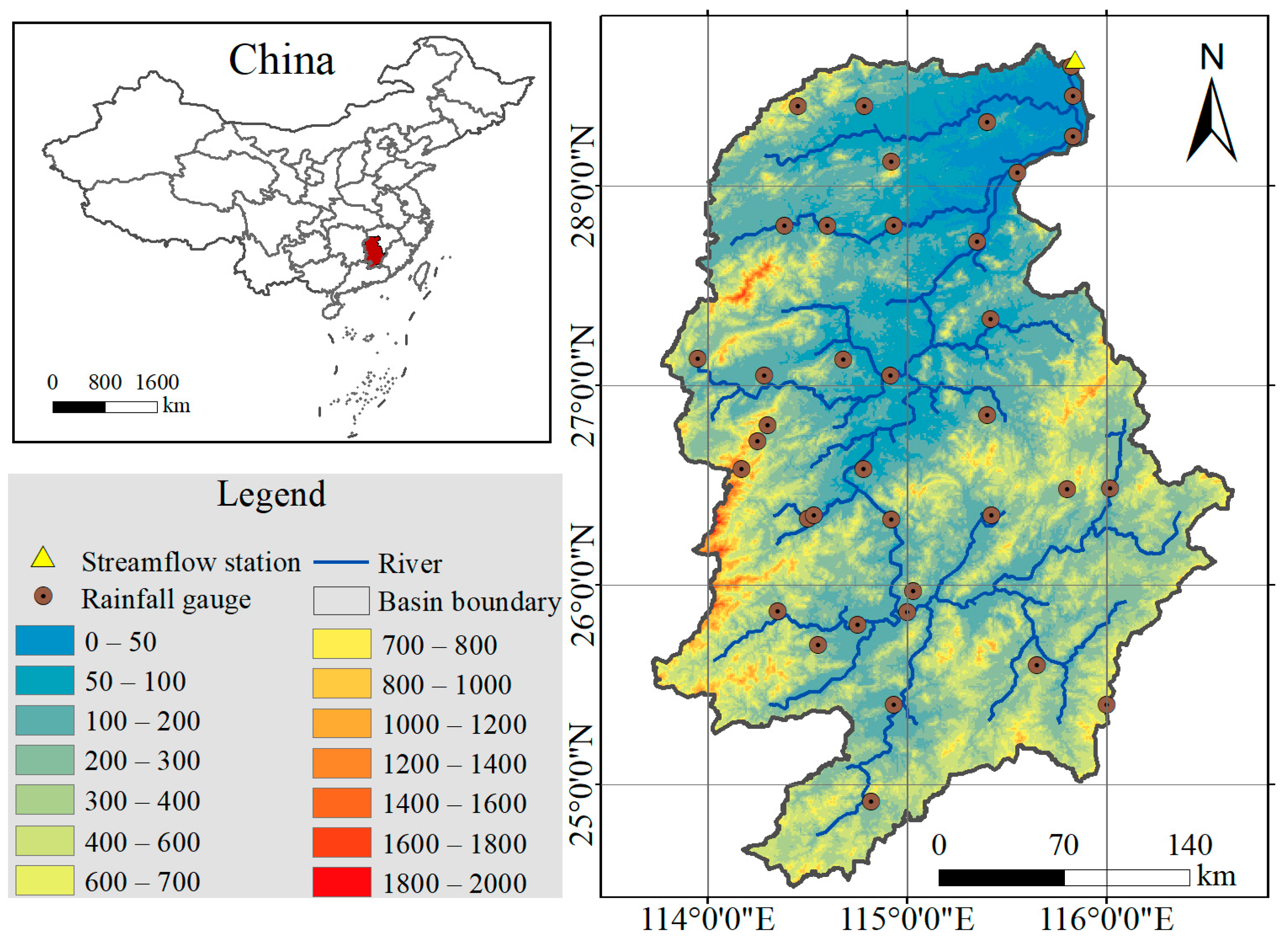
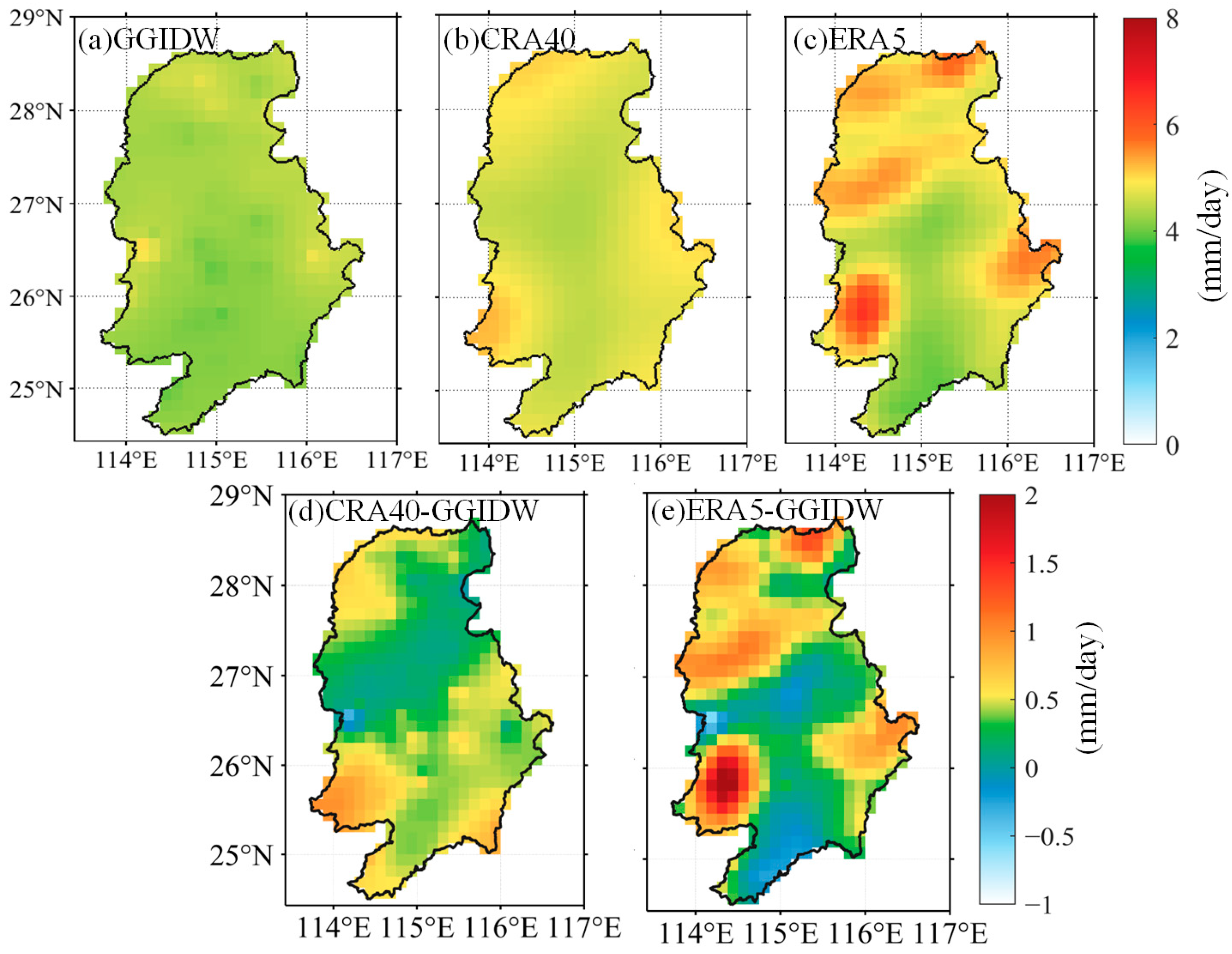
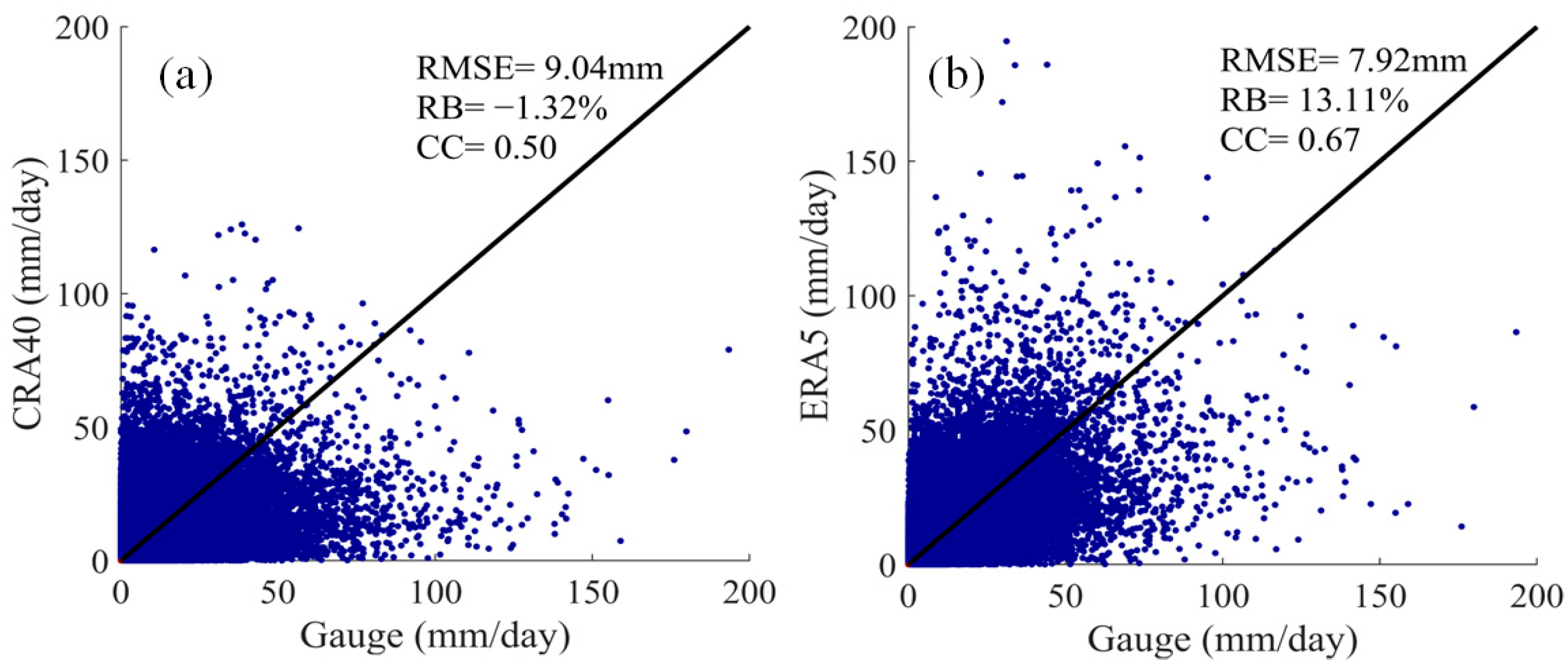
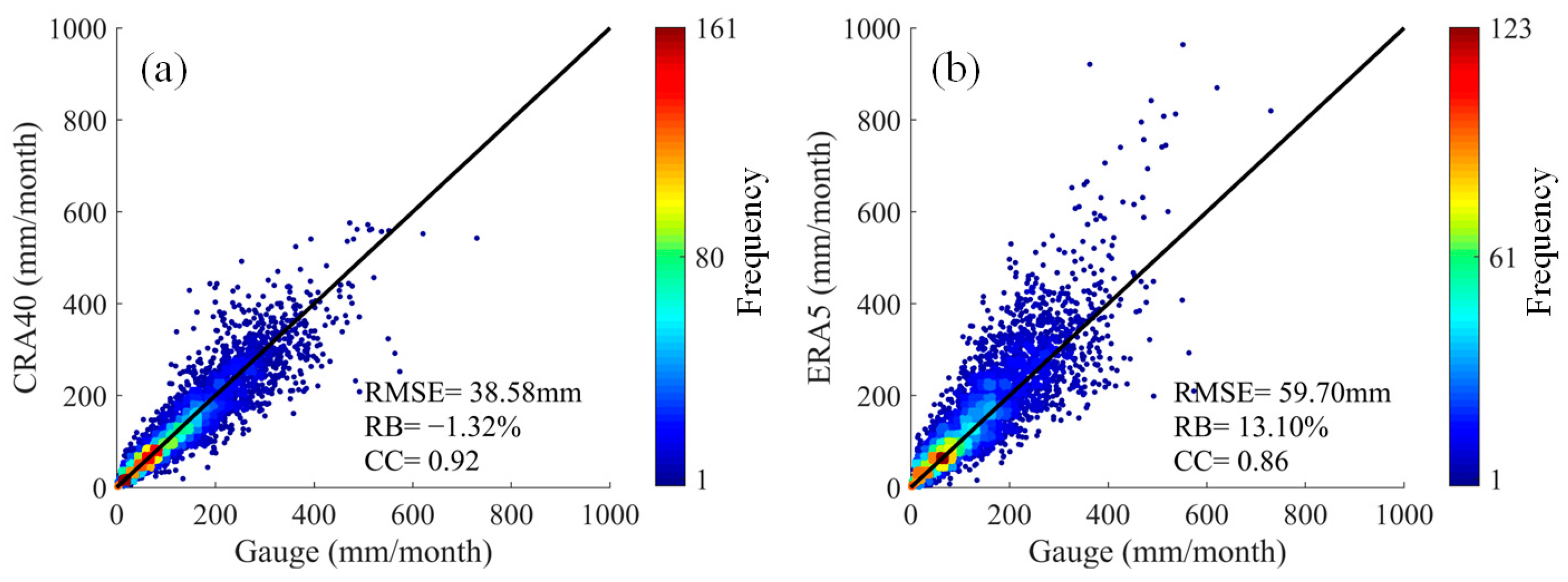
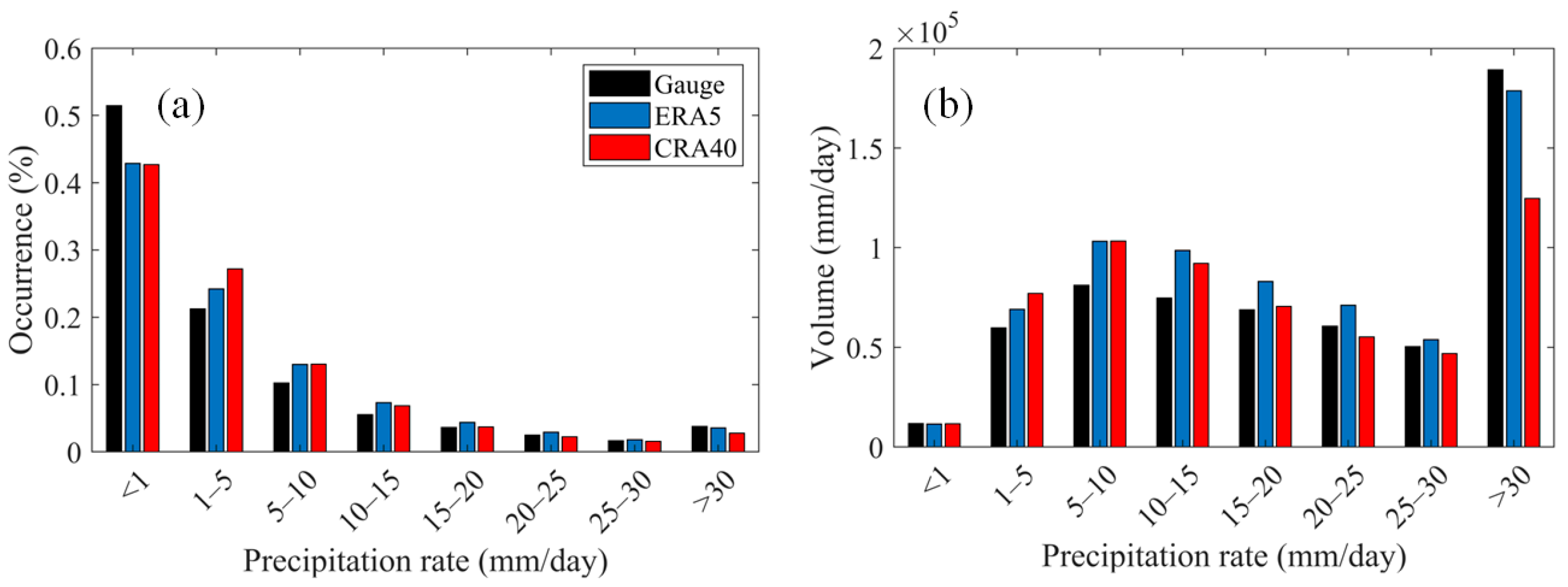

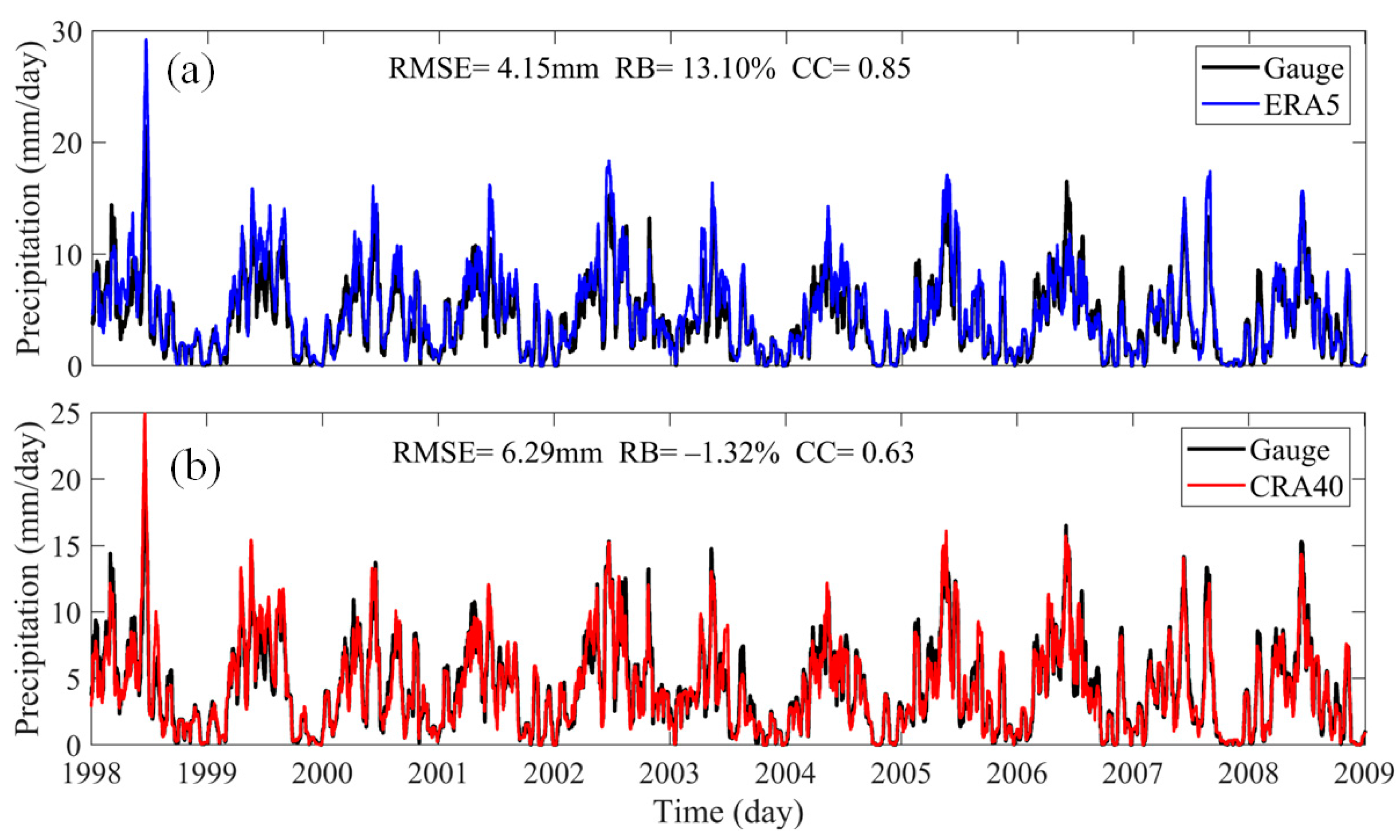
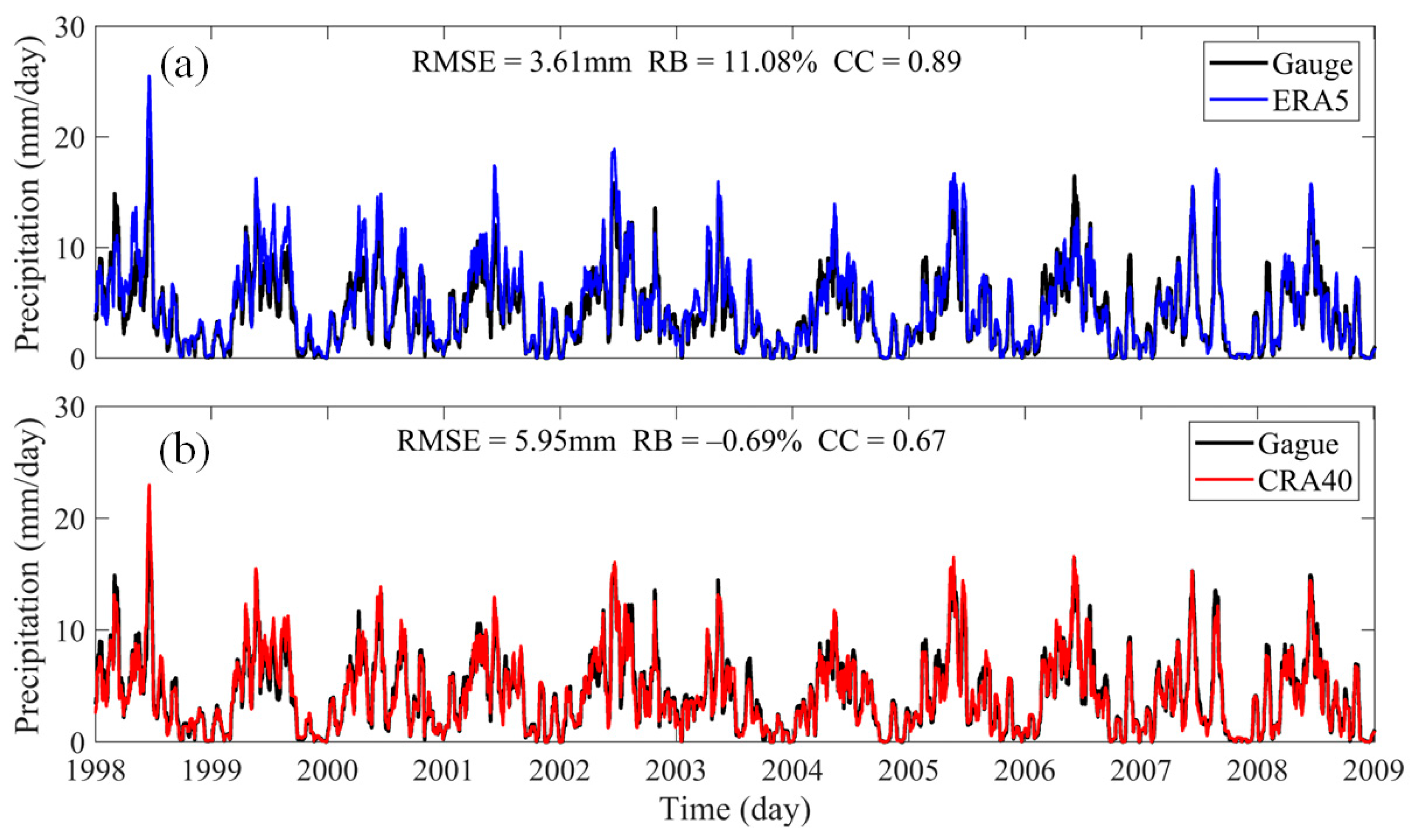
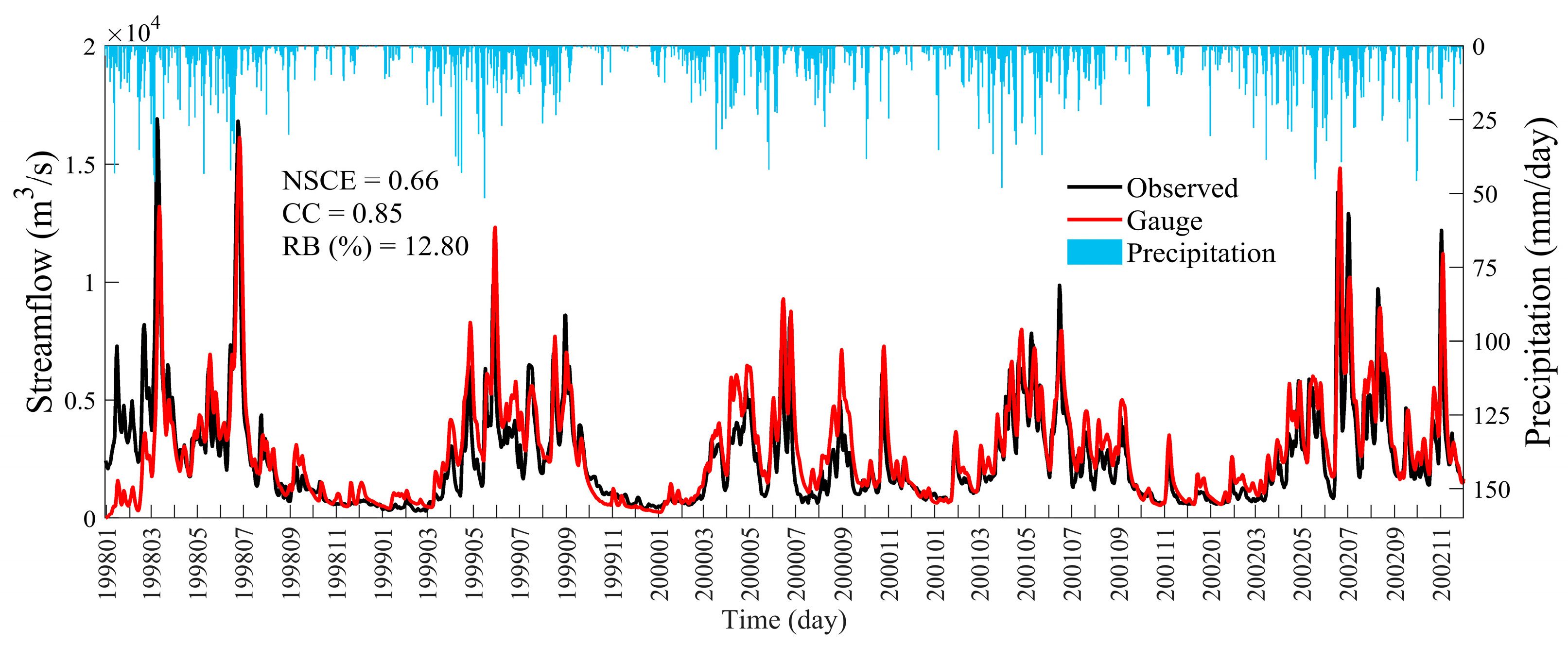
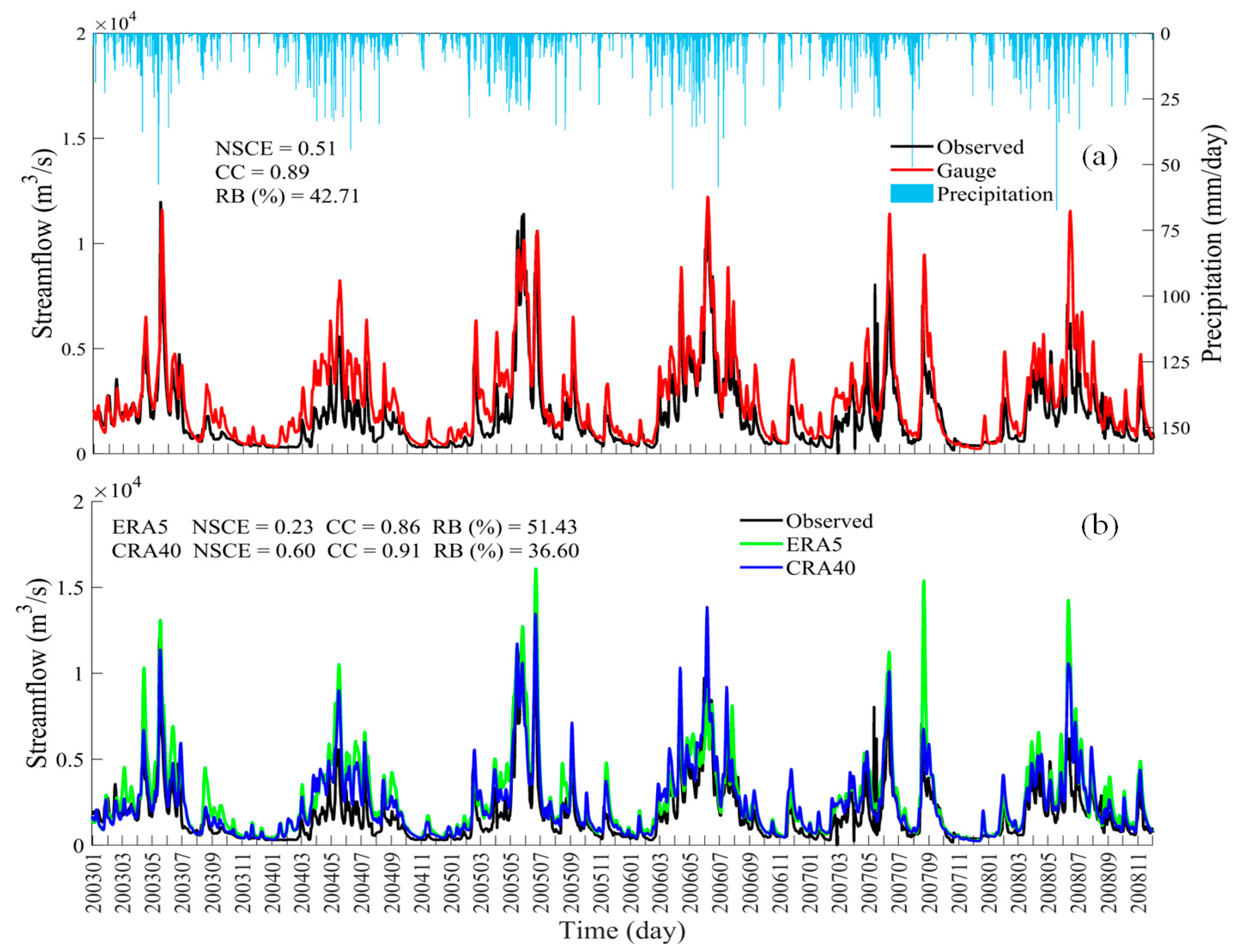
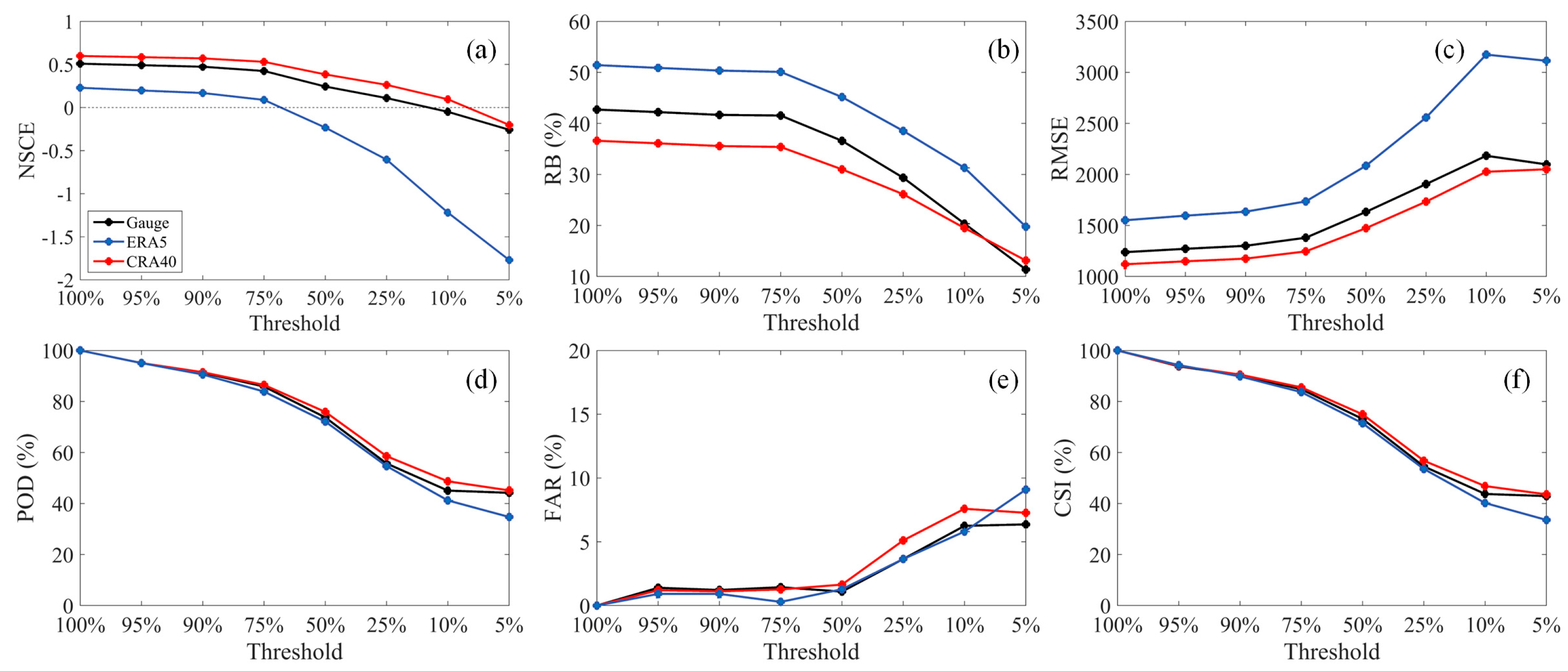
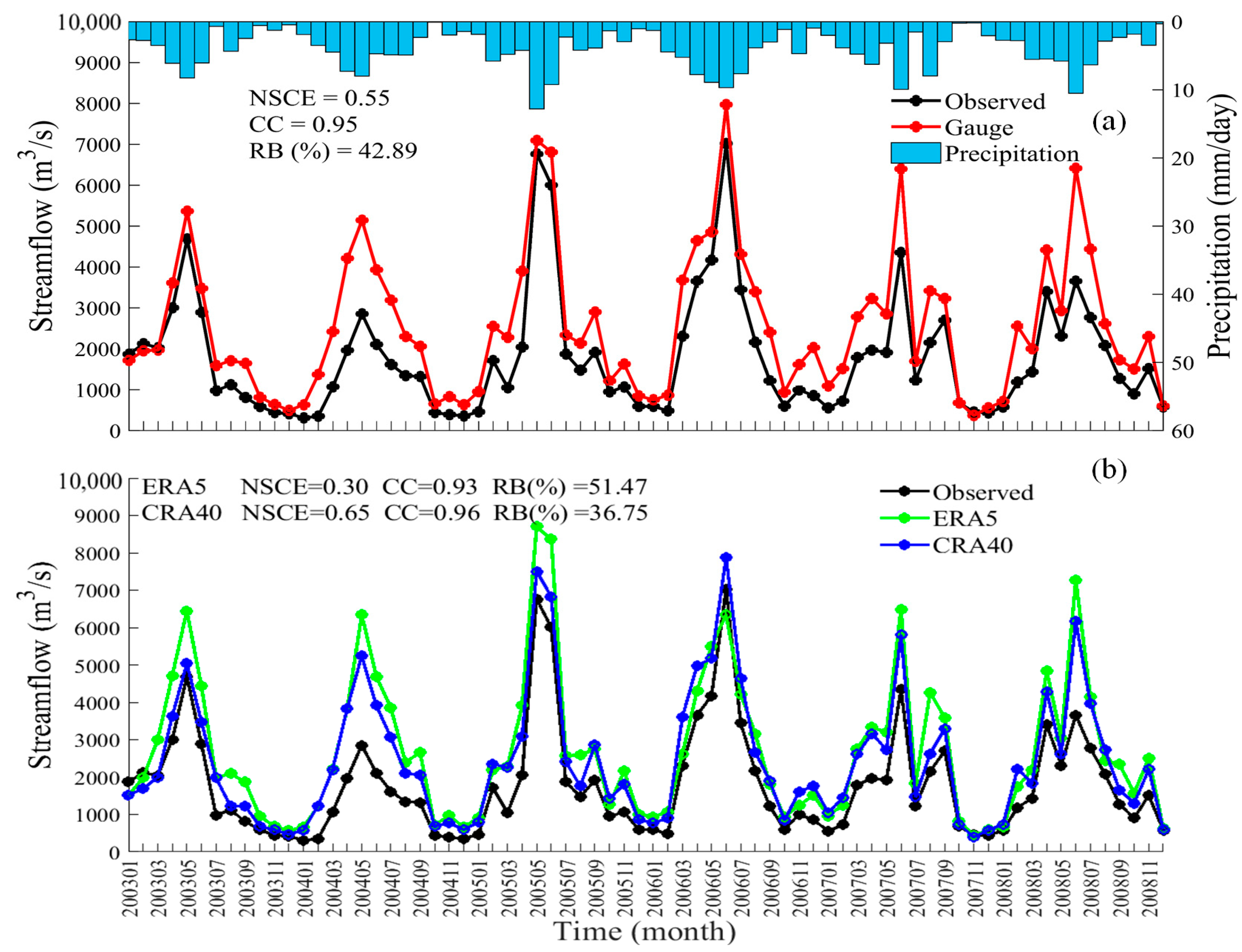
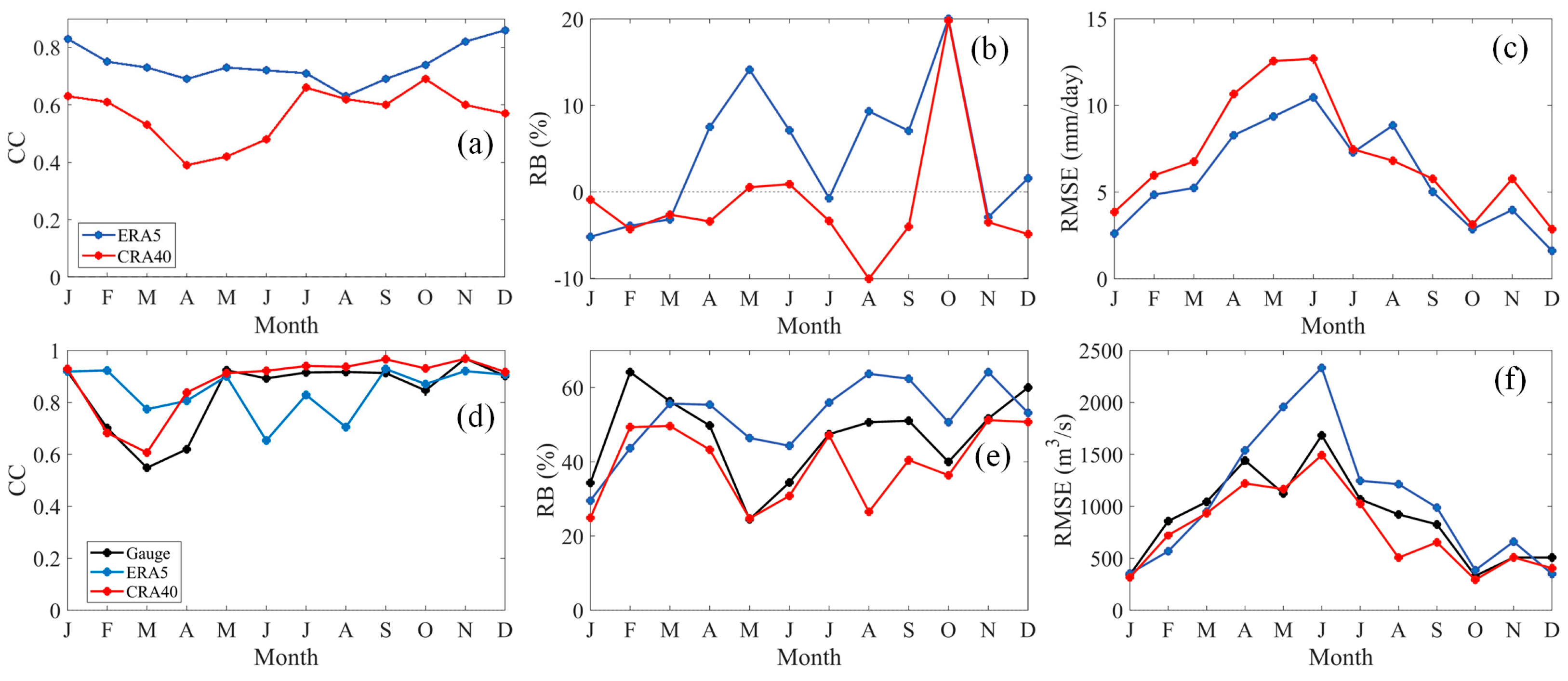
| Parameters | Definition | Value Range | Calibrated Value |
|---|---|---|---|
| B | Variable infiltration curve parameter (binfilt) | [0, 0.4] | 0.381697 |
| Dsmax | Maximum velocity of baseflow, (unit: mm/day) | [0, 30] | 13.748 |
| Ds | Fraction of Dsmax where nonlinear baseflow begins | [0, 1] | 0.630776 |
| Ws | Fraction of maximum soil moisture where nonlinear baseflow occurs | [0, 1] | 0.918032 |
| Depth2 | Second layer of soil thickness | [0, 2] | 1.248738 |
| Depth3 | Third layer of soil thickness | [0, 2] | 1.743027 |
| Value Range of NSE | Simulation Effect |
|---|---|
| [−∞, 0.50) | Poor |
| [0.5, 0.75] | Preferable |
| (0.75, 1] | Satisfactory |
| Season | Index | RB (%) | RMSE (mm/day) | CC |
|---|---|---|---|---|
| Spring | CRA40 | −2.48 | 11.62 | 0.37 |
| ERA5 | 11.95 | 9.24 | 0.65 | |
| Summer | CRA40 | 1.45 | 11.27 | 0.51 |
| ERA5 | 19.58 | 10.91 | 0.63 | |
| Autumn | CRA40 | −1.17 | 6.11 | 0.59 |
| ERA5 | 13.63 | 5.32 | 0.72 | |
| Winter | CRA40 | −3.65 | 4.69 | 0.55 |
| ERA5 | 1.64 | 3.75 | 0.72 |
Disclaimer/Publisher’s Note: The statements, opinions and data contained in all publications are solely those of the individual author(s) and contributor(s) and not of MDPI and/or the editor(s). MDPI and/or the editor(s) disclaim responsibility for any injury to people or property resulting from any ideas, methods, instructions or products referred to in the content. |
© 2024 by the authors. Licensee MDPI, Basel, Switzerland. This article is an open access article distributed under the terms and conditions of the Creative Commons Attribution (CC BY) license (https://creativecommons.org/licenses/by/4.0/).
Share and Cite
Li, Z.; Zhou, Z.; Chen, S.; Li, Y.; Wei, C. Hydrological Evaluation of CRA40 and ERA5 Reanalysis Precipitation Products over Ganjiang River Basin in Humid Southeastern China. Water 2024, 16, 2774. https://doi.org/10.3390/w16192774
Li Z, Zhou Z, Chen S, Li Y, Wei C. Hydrological Evaluation of CRA40 and ERA5 Reanalysis Precipitation Products over Ganjiang River Basin in Humid Southeastern China. Water. 2024; 16(19):2774. https://doi.org/10.3390/w16192774
Chicago/Turabian StyleLi, Zhi, Zelan Zhou, Sheng Chen, Yanping Li, and Chunxia Wei. 2024. "Hydrological Evaluation of CRA40 and ERA5 Reanalysis Precipitation Products over Ganjiang River Basin in Humid Southeastern China" Water 16, no. 19: 2774. https://doi.org/10.3390/w16192774
APA StyleLi, Z., Zhou, Z., Chen, S., Li, Y., & Wei, C. (2024). Hydrological Evaluation of CRA40 and ERA5 Reanalysis Precipitation Products over Ganjiang River Basin in Humid Southeastern China. Water, 16(19), 2774. https://doi.org/10.3390/w16192774






